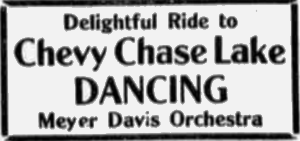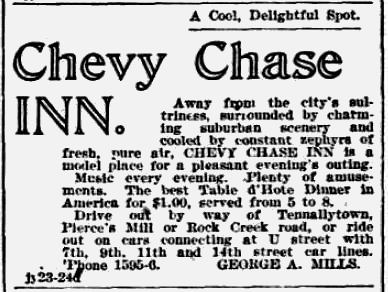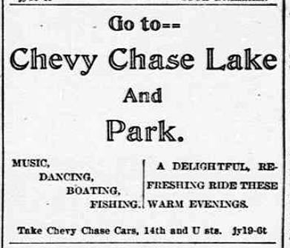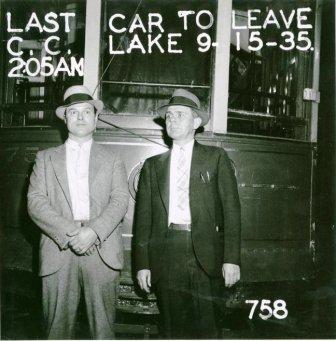Promoting Land Sales – Chevy Chase Inn and Chevy Chase Lake

To promote land sales, The Chevy Chase Land Company provided certain amenities and attractions for its new development. Among these was the Chevy Chase Club, an important element for attracting home buyers of a certain class. In addition, land was set aside for churches. And the Land Company built a hotel and an amusement park
Chevy Chase Inn -- "A Cool, Delightful Spot."

As an attractive lure to prospective home buyers, the Land Company began construction of a hotel in 1892 or 1893. The Chevy Chase Inn was built on the west side of Connecticut, a few blocks north of Bradley Lane, and opened in 1894 (at first, under the name of Chevy Chase Springs Hotel ). Designed by architect Lindley Johnson, the hotel offered pleasant accommodations in a rural setting, with amusements such as music and bowling, and good food, like the special “Table d’Hote” for $1.00. Unfortunately, the Chevy Chase Inn did not attract patrons in the cooler winter months, and in 1903, it was sold to the proprietors of a school for girls and young women, later called Chevy Chase Junior College. In 1951, the property was purchased by the National 4-H Foundation for a conference center. (Learn more about Chevy Chase Junior College at our online exhibit about the school.)
Chevy Chase Lake – the Trolley Park at the End of the Line
In 1894, the same year that Chevy Chase Inn opened, the Land Company began operating an amusement park around Chevy Chase Lake, drawing patrons from the whole region. Like nearby Glen Echo Park and Bethesda Park, the trolley park showcased the new suburb, and was intended to develop a market for house lots. The man-made lake created a lovely landscape feature for the trolley park, as well as the opportunity for boating, picnics, and all sorts of amusements. There was no charge for admission to the park, and almost anyone could sit on the rustic benches and enjoy a band concert.


"Take Chevy Chase Cars"
Numerous newspaper advertisements and publicity notices for Chevy Chase Lake featured the frequent streetcar service – “every three minutes” – “never any crowding” -- and the enjoyable ride through the still rural countryside. Much of the suburb was still undeveloped farm land, and the fresh air, along with cool breezes of the open summer streetcar, provided respite from the “sultry air” of the city. At the same time, streetcar riders saw the grand homes being built along Connecticut Avenue, and perhaps would decide to move to this new suburb. It was, after all, only a 35 minute streetcar ride from Downtown.
The Trolley Cars Stop Running in 1935

The streetcar line ended in 1935, replaced by buses – and by the increased use of automobiles. 1936 was the last full summer season at Chevy Chase Lake, although there were occasional events in the next few years. Although Chevy Chase Lake closed, the Chevy Chase Lake Swimming Pool located just across Connecticut Avenue, which opened in 1927, was operated by the Heon family into the 1970s. But like the other trolley parks that continued operation – such as nearby Glen Echo Park, and Baltimore’s Gwynn Oaks Park, the Chevy Chase Lake Swimming Pool would become the subject of controversy over its racially exclusive admission policies. By this time, Chevy Chase Lake, the trolley park at the end of the Connecticut line, had been closed for more than thirty years.


